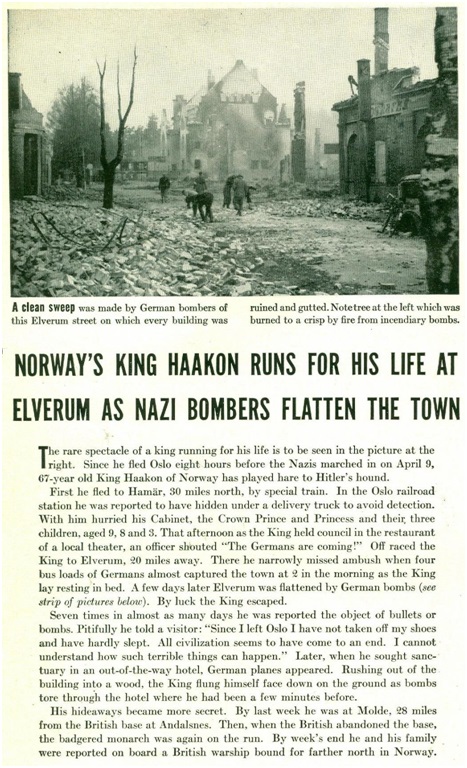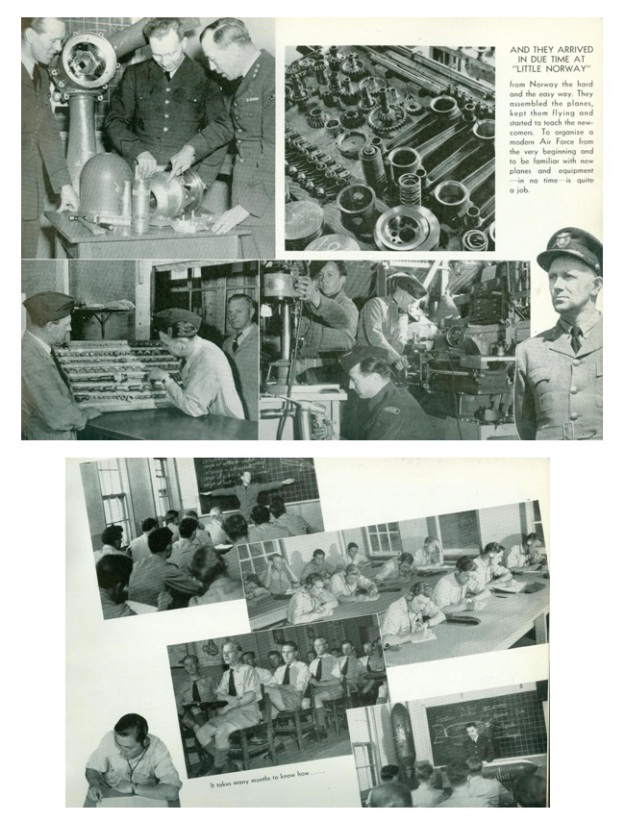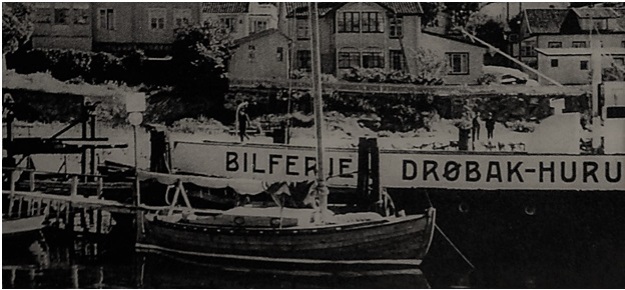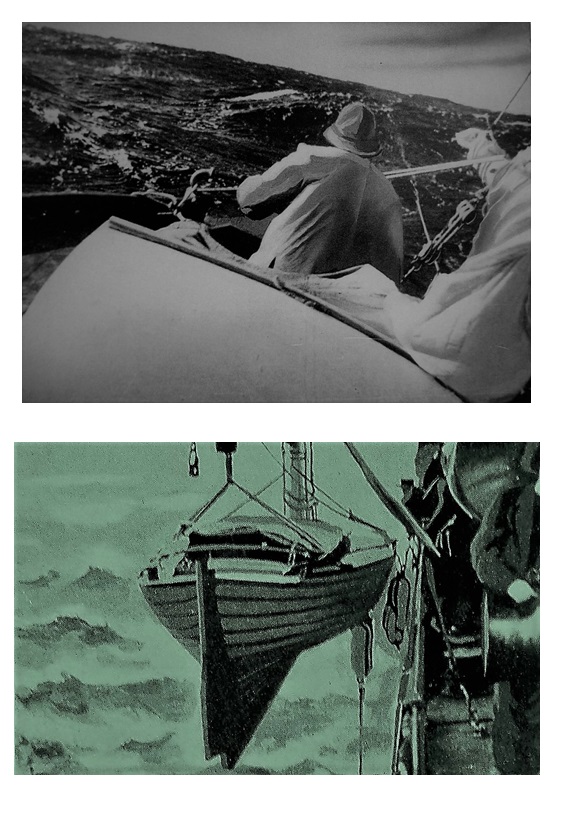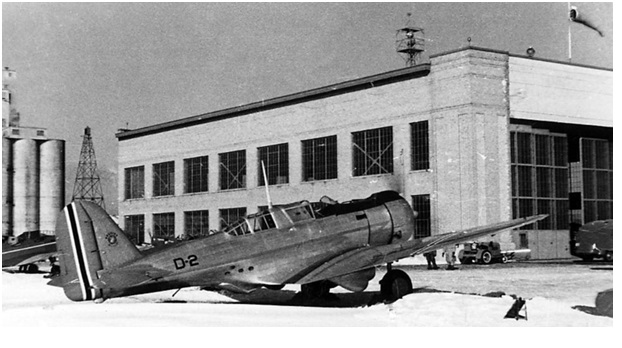Little Norway
Part Two
Where They Trained

1942 poster created for “Wings for Norway” campaign.
Norway became the first European country to train aircrews in Canada and the only country to establish their own air training program. This training was officially approved by the Canadian government in August 1940, and from this date on the Norwegians intended to carry out a complete 70-week air training programme. The first official training began on 21 September 1940, [eleven student pilots] with an introductory course, then Elementary training at Little Norway, followed by Advanced training in Curtiss and Douglas aircraft, then off to England and twin-engine training, followed by Operational Training in U.K. By February 1941, after thirty-five pilots had been trained at Little Norway, it became obvious the original training plans would be far too ambitious an undertaking and their air training program must be scaled back. The RCAF were fully absorbed into the organization, and construction of the B.C.A.T.P., so the Norwegian government in exile in United Kingdom approached the British Air Liaison Mission and ask if they could use the RAF Schools in Canada to train pilots beyond the elementary stage. They also ask permission to use the RAF and RCAF schools to train air observers, air bombers, and air gunners. The Norwegian Air Force were now assigned advanced pilot training on Harvards at two RAF schools in the Prairies, No. 32 S.F.T.S. at Moose Jaw, Saskatchewan, and No. 34 Service Flying Training School at Medicine Hat, Alberta.
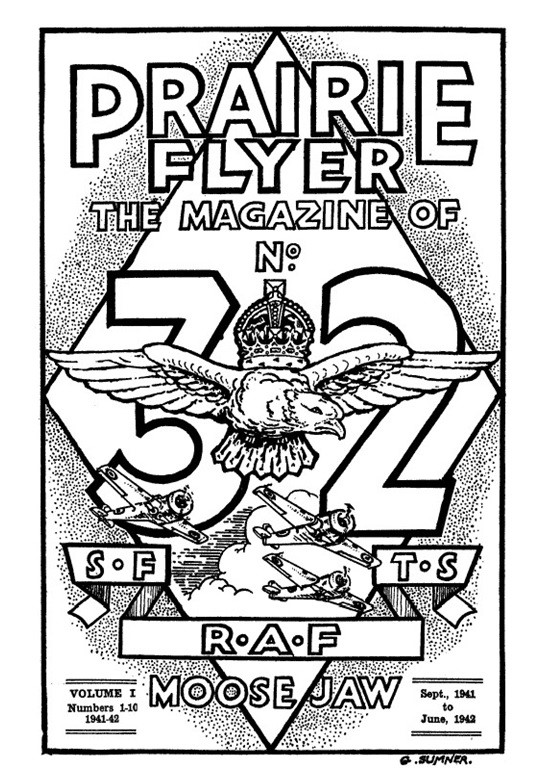
The first issue of Prairie Flyer, cover by RAF artist L.A.C. Sumner G.A.,
September 1941
FIRST Course #14 begins 16 April 1941. Three Norwegian flying instructors and eighteen pilot students arrived at No. 32 SFTS Moose Jaw, Saskatchewan.

On 13 July 1940, the Canadian government gave the OK for the movement of four RAF service flying training schools from the United Kingdom to Canada. In August, this was revised to eight S.F.T. Schools, two Air Observer schools and one General Reconnaissance school. These new RAF schools would be constructed by the Canadian government but all costs for operating and RAF training was borne by the United Kingdom. The move to Canada began in October 1940, and No. 32 S.F.T.S. arrived at Moose Jaw, Saskatchewan, in November where it was -11 degrees C. Due to the lack of British Oxford twin engine aircraft for training, No. 32 S.F.T.S. was issued with 71 new Harvard trainers and began training on 9 December 1940. That is why the first Norwegian student pilots were posted to No. 32 S.F.T.S. of the RAF for single engine Harvard training, Course #14, beginning on 16 April 1941.

The Canadian RAF schools were commanded by their own officers, who more or less followed the British customs and traditions, which preserved British national identity in Canada. The magazine was totally British content, even [above] cartoons, and there was no mention of the Norwegian student pilots in the RAF “Prairie Flyer” News Magazine.
The first Norwegian Harvard trainer fatal accident took place at the relief landing field, 20 May 1941.


SECOND Course # 21 begins 26 June 1941. Twenty-two Norwegian student pilots and two instructors arrived that evening.
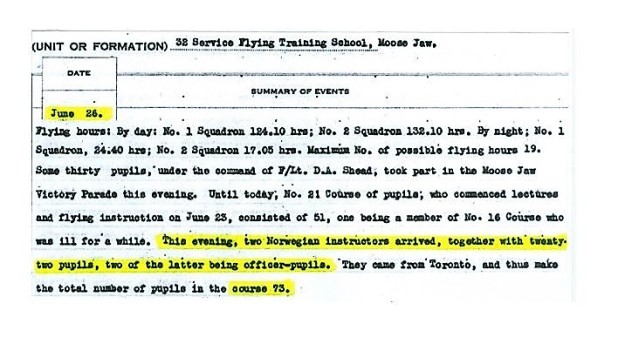
1 August 1941, 06:25 hrs. serious accident to Harvard #2804. On cross-country flight Norwegian student pilot #568 Cpl. Drangshelt, E.C. attempts a forced landing due to shortage of fuel, and was slightly injured.
13 August 1941, Harvard #2567 and Harvard #2627 collided in mid-air whilst on formation flying. LAC P.V.G, Sandman #2567 bailed out landing satisfactory. Harvard destroyed. Cpl. G. E. H. Grundt-Spang of the Royal Norwegian Air Force, flying solo in Harvard #2627 landed safely, aircraft slightly damaged.
21 August 1941, 07:30 hrs. minor accident to Harvard #2748. Cpl. G.P.L. Owren, student pilot R.N.A.A.F. was flying solo and entered a drive, due to excessive speed the fuselage front side panels were torn off his Harvard.
31 August 1941, Wings presented to Course #21, two pupil officers, four sergeants, and 15 corporals of the Norwegian Air Force. Wings parade presented by Captain Jenn-Hansen who flew from Little Norway, Toronto, for the event. One student pilot failed his wings.
THIRD Course # 27 begins at 06:00 hrs 1 September 1941. One 2nd Lt. and twenty-two student pilots arrive. The school has 78 Harvard trainers on strength. 18 September 1941, Cpl. F. Cleve, RNAF, swung on landing in Harvard AJ731, slight damage.
Wings Parade for course #27 by Capt. C. R. Nagvik, RNAF, who flew in from Toronto, Little Norway. One Norwegian officer and twenty pilots received wings, two failed.
FOURTH Course #35 began on 29 December 1941, 15 Norwegians, all graduated on 10 April 1942.
FIFTH Course #53 begins on 12 April 1942, 18 Norwegian student pilots, all received wings on 31 July 1942.
SIXTH Course #59 begins on 5 July 1942, ten Norwegians in a class of 60 personnel. 25 July 1942, one RAF and one RCAF student of course #59 are killed this day. Pte, O. Gabrielsen RNAF, flying Harvard AJ637 has a mid-air 22 miles east of Wymark, Saskatchewan. The Canadian is killed and Gabrielsen makes it back to base, uninjured.
Wings Parade for Course #59 is held on 23 October 1942, the very last Norwegian class to train at No. 32 SFTS Moose jaw, Saskatchewan. The British RAF school has received 95 twin-engine Oxford trainers and the Harvard trainer is gone. All future training of RNAF student pilots will now move to RAF No. 34 SFTS at Medicine Hat, Alberta, where Norwegian training began on 1 September 1941.
In nineteen months [16 April 1941 to 23 October 1942] No. 32 RAF S.F.T.S. at Moose Jaw, Saskatchewan has trained and graduated 104 Norwegian student pilots in the RCAF Harvard trainer.


Sgt. Marius Eriksen [bottom far right] took his training at No. 32 SFTS but his course number is not known. [Possibly Course #21 – 26 June 1941] His famous career in the RAF can be found on a number of websites. He first flew with No. 331 [Norwegian] Squadron RAF, photo taken at RAF Catterick, England, August 1942. Author painting replica.

No. 331 [Norwegian] Squadron was formed at RAF Catterick on 21 July 1941. These images were taken around 19 August 1942, Dieppe Raid.
The first Norwegian class at No. 34 S.F.T.S. RAF Medicine Hat, Alberta, became course #27, which began on 1 September 1941. In February 1943, RAF Sgt. L. Bolton created an official [rare] RAF school unit badge which was approved by King George VI, November 1943.

From April 1941, Little Norway at Toronto and later at Muskoka [May 1942] became an elementary flying training school for Norwegians, following the same standards and training syllabus as the RCAF British Commonwealth Air Training Plan. Four hundred Norwegian pilots were trained to the elementary flying level at Little Norway [Toronto and later Muskoka] and subsequently three-hundred and twenty-five graduated to wings standard at other RAF and RCAF Service Flying Training Schools in Canada. You can now follow the order of merit given to the first 23 Norwegian pilots by their British RAF flying instructors at No. 34 Service Flying Training School at Medicine Hat, Alberta. It is interesting to read how the British ranked each pilot on three choices of most suitable aircraft he should be assigned. Upon receiving their Norwegian wings, the new pilots were returned to Little Norway for service training on assigned fighters or bombers, then off to England or Iceland for operational training and combat. The Norwegian nominal roll was kept separate from the British RAF student pilots in training at 34 SFTS Medicine hat, Alberta. The list of Course #27 [1 September 1941] and Course #53 [13 April 1942] now follows.

The Norwegian student pilot marks from Course #27



This graduation class #65 at 34 SFTS Medicine Hat, Alberta, 22 January 1943, featured pilots from Czechoslovakia, Fiji, France, Holland, and four Norwegians from Little Norway.

The Allied foreign pilots had their photo taken separate from the 39 RAF pilots.
The training of student Norwegian pilots continued –
Course #69 – 20 March 1943 – Nine student pilots
Course #71 – 16 April 1943 – Six student pilots
Course #73 – 14 May 1943 – Two student pilots
Course #77 – 9 July 1943 – Twelve student pilots
Course #79 – 6 August 1943 – Nine student pilots
Course #81 – 3 September 1943 – Two student pilots
Course #85 – 29 October 1943 – Ten student pilots
Course #87 – 26 November 1943 – One student pilot

This marked the end of Norwegian training at Medicine Hat, and only one Norwegian student pilot remained training in Course #87. Posted back to Muskoka for final Norwegian training.



Sgt. F. N. Ostervold became the last Norwegian student pilot to train and graduate from R.A.F. No. 34 Service Flying Training School at Medicine Hat, Alberta. The British school graduated 99 Norwegian student pilots who were all posted back to Little Norway at Muskoka, Ontario, to complete their training before going overseas.
No. 16 Service Flying Training School at Hagersville, Ontario, opened its doors on 8 August 1941, an RCAF twin-engine school flying Avro Anson aircraft. The second RCAF news Magazine was titled “The 16th Oracle.”

The first three Norwegian Courses at No. 16 SFTS Hagersville [#90-#92-#96] trained eleven student pilots selected for twin-engine bombers and they graduated from flying the RCAF Avro Anson Mk. I, II, and III.
By September 1943, the flow of Norwegian recruits arriving at “Little Norway” Muskoka began to slow down. It was becoming clear for economical and advantageous reasons; the structure of Norwegians advanced training student pilots must be directed to other RCAF schools in the B.C.A.T.P. The first twin-engine advanced training of Norwegian students at No. 16 SFTS Hagersville, Ontario, began with Course #90 on 19 September 1943, when one RNAF instructor and two airmen were taken on strength and three student pilots arrived for training. On 20 September 1943, RCAF Liaison Officer F/L S.K. MacDonald was attached to the RNAF and he arrived at Hagersville to observe the new Norwegians training in the Anson.

Course #90 graduated on 11 February 1944, and the three student pilots were posted back to Muskoka, [Little Norway] for further training.
Course #92 began on 17 October 1943, with five RNAF student pilots in training and they graduated on 10 March 1944, posted to Muskoka, Little Norway.
Course #96 began on 12 December 1943, with three RNAF student pilots. All three graduated 5 May 1944, posted to Muskoka.
Course #100 began on 27 January 1944, with original intake of 68 trainees. This was a new special course which trained in two aircraft [Harvard and Anson] taking 28 weeks to complete. Eight RNAF students graduated and were posted to Muskoka 26 August 1944.

At the end of January 1944, No. 16 SFTS at Hagersville took on a new revolutionary [one-of-a-kind] training program involving two different aircraft, the Harvard and Avro Anson. They had on strength 73 Avro Anson twin-engine and 50 Harvard single-engine trainers. Course #100 became the experimental training course which lasted for seven months of training, fourteen weeks in a Harvard and fourteen weeks in an Anson. Hagersville became the only service flying training school in the BCATP employing this two-type training method. Eight RNAF student pilots graduated from this special first course and one Sgt. Storm-Larsen was married at the end of his training. His new Canadian bride had the honor of pinning his wings on her husband’s uniform in front of his Commanding Officer and special guests. Two Norwegian Cornells arrived from Little Norway and put on an aerobatic display for the graduation ceremony, plus a Canadian built Lancaster Mk. X arrived from Malton, Ontario, to give rides to the graduation class.

Thirty-eight RNAF student pilots were the only Norwegians to receive this special dual fourteen weeks training in the Harvard and Avro Anson. Under the old system pilots who trained on single engine trainers became fighter pilots, and twin-engine pilots went to bombers. These BCATP dual trained pilots could be assigned to fighter or bomber aircraft. This replaced the need to re-train Norwegian pilots at Little Norway, [Muskoka] as they could now be sent directly to England or Iceland, for Operational Training duties.

In total thirty-eight Norwegian student pilots received Wings under this dual training program and graduated as qualified to fly both fighter and bomber aircraft. This new training program became a perfect fit for the Norwegians pilots in both time and cost. Four other BCATP schools would adopt this new training [Harvard – Anson] before the end of World War Two. [No. 9 SFTS, No. 13 SFTS, No. 14 SFTS, were RCAF and No. 41 SFTS which was an RAF School]

Course #104 began on 11 March 1944, containing another eight Norwegian student pilots. This was another 28-week course in both Harvard and Anson, with graduation on 20 October 1944.

Twenty-two more Norwegians would be trained at No. 16 S.F.T.S. Hagersville until 31 March 1945. In total 49 student pilots received their wings, [38 on the dual aircraft training course] and five RNAF members were on staff at the school.

On 29 May 1943, Lt. Commander R.J. Thommassen of the Royal Norwegian Navy arrived at No. 1 S.F.T.S. Camp Borden to study training methods and arranged for future Norwegian student fighter pilot courses. After the Norwegian student pilots received their wings at No. 1 SFTS they returned to Little Norway, Muskoka, Gravenhurst, Ontario, where Lt. Tommassen was placed in charge of the next phase of RNAF training.

The first Course of eleven Norwegian student pilots trained at No. 1 S.F.T.S. Camp Borden began on 18 September 1943, and received their wings on 11 February 1944. The Harvard trainer was featured on the front cover page for the RCAF magazine “Wings Over Borden” during their training period. The RNAF student pilots would attend seven different courses at Camp Borden [#90, #96, #100, #104, #113, #118, and last #121] where 78 would receive their wings. This Norwegian training at an RCAF SFTS was covered in great detail by the Canadian Press Corps, appearing in local newspapers.







Out of 52 pilot graduates the Norwegians came 1st and 2nd in Course #96, 5 May 1944.
Course #100 graduates on 10 August 1944, and seven more Norwegians received their wings.
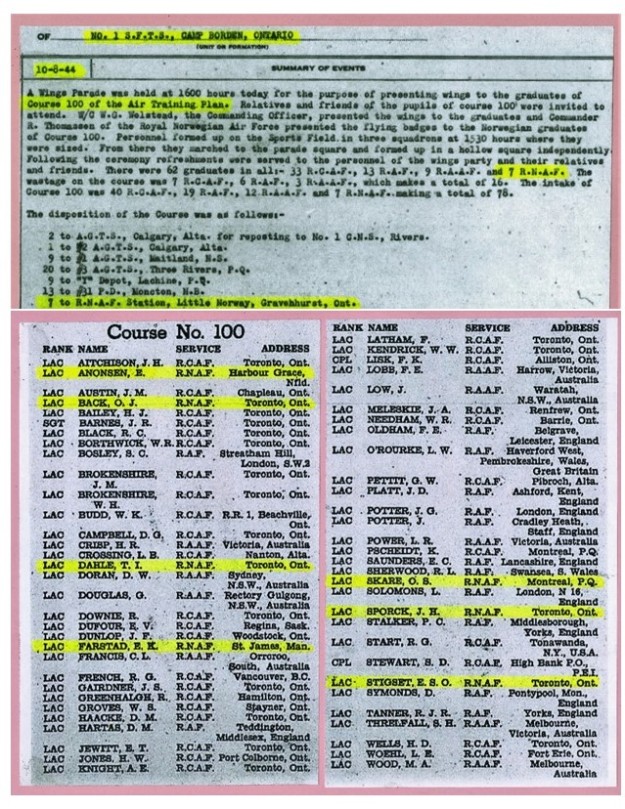
Course #104 graduated ten RNAF pilots, 19 October 1944.

Course #113 contained twenty-two Norwegian student pilots.


The last Norwegian student pilot training course held at Camp Borden became #121, which graduated nine pilots on 29 March 1945.

The Norwegian government provided all elementary training aircraft, [plus early advance trainers] training equipment, plus instructors, paying the total cost for all training in Canada. The Norwegian Merchant Marine Navy had the 4th largest fleet in the world at this time, which paid the total cost of training in Canada. This Merchant marine fleet supplied Great Britain with 50 per cent of her oil and one-third of all supplies during the war. That is why the RAF schools in Canada trained hundreds of Norwegian aircrew during WWII; the math is simple to add up. My history mainly covers the Norwegian pilots trained in Canada, recorded in their Daily Diary by the RAF and RCAF, which totals 325 pilots. In total 3,593 Norwegian personnel served at Little Norway, [Toronto and Muskoka] in which 2,500 were troops trained in Canada, this includes all ranks and trades. Aircrew training total is recorded in Ottawa as 677, with 426 of these being pilots. Records are not clear on how many Norwegian pilots were trained and received their wings at Little Norway, Toronto Island Airport, but it appears to be between 30 to 35 up until April 1941. My calculations record possibly 40 Norwegian pilots [Army and Navy] received their wings at Little Norway, Toronto Island Airport.
In 1941, the RCAF course for air bombers and air observers was very much the same. For Canadian RCAF air observer student’s instructions began at Initial Training School which lasted for six weeks. This is where they were introduced with the tools of the trade, compasses, drift recorders, sextants, and they were given instructions in solving textbook problems in navigation. Next came bombing and gunnery school which lasted eight weeks, then on to six weeks at air observer school. No. 1 Bombing and Gunnery School, at Jarvis, Ontario, officially opened on 19 August 1940, with the first RCAF class of 58 students [Air Gunners] graduating on 30 September 1940. This class now moved on to six weeks of Air Observer training.

On 16 December 1940, Group Capt. Izzit, RNAF, conducted the first conference with Air Commodore B.E. Brookes, OBE, with regards to training of Norwegian Air Observers and Air Gunners. A second meeting took place on 13 January 1941, when His Royal Highness Olav of Norway met with Air Commodore Brookes over a special luncheon in Toronto. The cost, length of course, and other details were discussed and agreed upon in principal.
The first eleven Norwegians arrived at No. 1 B & G School, Jarvis, on 17 February 1941, three Air Observers and eight Air Gunners. This course for Norwegians would last for eighteen weeks and the cost would be estimated on 24 March 1941, at $17,000 per Norwegian student for the full eighteen weeks of training. On 3 March 1941, Lt. Commander P.W. Lea, RNAF, arrived at Jarvis for a special course, [#13] possibly part of the same Air Observer course, which graduated on 12 April 1941, with three RNAF students.
Course #15, 7 June 1941, graduated three RNAF students as Air Observers.
Course #23, 30 August 1941, graduated six RNAF students as Air Observers.
In June 1942, the RCAF began phasing out the training of air observers, which ended in October. On active operations the air observer was being overworked and could not give proper attention to the navigation of his aircraft. This created special training of navigators and the course was extended from twelve to twenty weeks. The new course gave more air time practice for the student and the complete course became more intense, plus borderline students were failed. Two new RCAF categories were created in November 1942, navigator bomber [B] or navigator wireless [W].
Course #31, 6 June 1942, graduated eight RNAF students as Wireless Air Gunners. Seven were sent to No. 4 A.O.S. London and one to No. 1 A.O.S. Malton, Ontario, to complete training.
Course #40, 10 October 1942, graduated six RNAF as air gunners. Return to Toronto.
Course #42, 7 November 1942, graduated twelve RNAF as air gunners. Return to Toronto.
Course #44, 9 January 1943, graduated two RNAF as air gunners. Return to Toronto.
Course #52, 15 May 1943, graduated ten RNAF as air gunners. Return to Toronto.
Course #53, 29 May 1943, graduated one RNAF as Navigator “B”. Return to Toronto.
Course #79, 25 June 1943, graduated one RNAF Navigator “W”, posted to No. 1 A.O.S. Malton.
Course #57, 26 July 1943, graduated one RNAF as air gunner. Return to Toronto.
Course #85, 20 August 1943, graduated two RNAF as Navigator “B”. Posted to No. 1 A.O.S. Malton.
Course #88, 17 September 1943, graduated one RNAF Navigator “B”. Posted to No. 1 A.O.S. Malton.
Course #67, 11 December 1943, graduated one RNAF Wireless air gunner. Posted to H.Q. at Toronto.
Course #93, 1 January 1944, graduated one Navigator “B”. Posted to H.Q. Toronto. This became the last Norwegian trained by the RCAF schools at Jarvis and Malton, Ontario.
In total 87 Royal Norwegian Air Force students were trained at RCAF No. 1 Bombing and Gunnery School at Jarvis, Ontario, and No. 1 Air Observer School at Malton, Ontario. With the new course extended in June 1942, this training at the very least cost Norway $100,000. War is not cheap.
One of the Norwegian BCATP schools of training most often omitted by historians is No. 1 RCAF, General Reconnaissance School at Summerside, P.E.I. This was a special school opened on 6 July 1942, consisting of 21 courses [17 for pilots and 4 for Air Observers ‘Navigators’]. The pilot’s course was nine weeks and the Air Observer [Navigator] was four weeks. Each class consisted of 24 trainees and some students were moved from one course to another.

This was the information each arriving student received at the start of training and the marks assigned for each course. The first four Norwegians arrived for Course #24, 29 December 1942. This course graduated General Reconnaissance Navigators on 22 January 1943, two RNAF officers failed and two graduated back to Little Norway. The two failures were transferred to a later course.
Course #75, graduated five RNAF Pilots on 25 January 1943, and none began with this course.
Course #27, graduated one RNAF Navigator on 5 March 1943.
Course #28, graduated three RNAF Navigators on 2 April 1943, one RNAF student was transferred to a later course.
Course #85, Pilots graduated two RNAF officers on 5 April 1943.
Course #32, graduated three RNAF Navigators on 31 May 1943.
Course #34, began 18 May 1943 – graduated six Navigators on 25 June 1943.
Course # 35, graduated one RNAF Navigator on 31 May 1943.
Course #85, graduated two RNAF Pilots on 4 June 1943.
Course #37, began training 5 July 1943, and graduated one RNAF officer and three airmen on 3 August 1943.
Course #38, began 12 July 1943, and graduated five Navigator N.C.O.s on 3 September 1943.
Course #39, began 26 July 1943, and graduated one RNAF Navigator on 3 September 1943.
Course #102, pilot course began 2 August 1943, and graduated three N.C.O.s on 1 October 1943.
Course #40, began 9 August 1943, and graduated two RNAF officers as Navigators on 18 September 1943.
Course #42, began 8 September 1943, and graduated five RNAF Navigators on 15 October 1943.
Course #44, began 25 October 1943, and graduated five RNAF as Navigators on 12 November 1943.
Course #114, pilot course, began 25 October 1943, and graduated seven 22 December 1943.
Course #106, pilot course, and graduated four, one failed, 29 October 1943.
Course #115, began 1 November 1943, and graduated two RNAF officers on 31 December 1943.
Course #49, began 13 December 1943, and graduated six RNAF in 1944.
The training of Norwegian pilots and ground crews continued in 1944 and early 1945, my count records forty-one more graduated from RCAF Summerside, P.E.I. The total Norwegians trained appears in my count to be around 100 RNAF students and most were Sgt. Navigators. One Norwegian was sent to hospital and another was transferred to a later course due to poor grades. It is possible these two students never graduated. The lack of Norwegian names, which were never recorded or attached to the RCAF Daily Diary, makes for much guess work.
On 1 February 1944, No. 1 General Reconnaissance School [RCAF] Summerside and No. 2 Air Navigator School at Charlottetown, P.E.I. [21 February 1944] were both combined under new RCAF Reconnaissance and Navigation School training programs. The war was coming to an end, and the RAF had disbanded at Charlottetown, and had returned to England. The various RCAF courses in navigation were now completed in the next few months, and at least four RNAF students would graduate from No. 1 N. and R School at Summerside.
On 4 February 1944, No. 1 Navigational and Reconnaissance School officially began training at Summerside, P.E.I.

A new training school news magazine now appeared titled RECCO, with cover designed by RCAF staff instructor artist Sgt. Dick DuPord. The new school had on charge 118 Avro Anson Mk. V training aircraft in May 1945, when the above issue [V-E] Victory Europe was issued.
Course #170, 2 February 1945, graduated two RNAF students.
Course #172, 16 February 1944, graduated one RNAF student.
Course #178, 29 March 1945, transferred one RNAF student [Lt. pilot] due to sickness. Graduated #179 course on 6 April 1945.
Course #80, 29 March 1945, graduated one RNAF officer, two transferred to course #82.
Course #82, 13 April 1945, transferred one RNAF student to class #84.
Course #187, 1 June 1945, graduated one RNAF student. The very last course with Norwegian training, six graduated.

Artist Sgt. DuPord created a 100% per cent Canadian Avro Anson pin-up girl who appeared in each issue of RECCO. The WWII school was disbanded on 15 September 1945, but continued postwar RCAF training until 1950.
The other [sister-school] General Reconnaissance School [Royal Air Force] was located next door at Charlottetown, P.E.I. No 31 G.R.S opened on 20 January 1941, and trained mostly RAF students, a good number of Australians, and a few RCAF, Poles, and Czech students after mid-1942. The British also trained 43 Norwegian Sgt. Navigators at No. 31 G.R.S. in five Courses. Unlike the RCAF this British RTAF school recorded all the Norwegian names in a normal roll for each course, and I have only added the dates of training. This saved a good section of Norwegian NCO navigator student training records. An unknown British artist also revealed his hidden talents to the international students.

 Arrival at No. 31 G.R.S. Charlottetown, P.E.I. by unknown British artist.
Arrival at No. 31 G.R.S. Charlottetown, P.E.I. by unknown British artist.




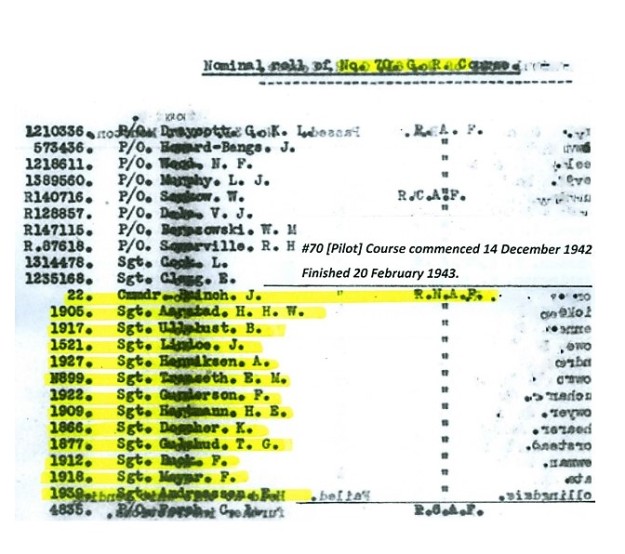
The last Norwegian course to train at No. 31 G.R.S. In total 43 student Sgts. were trained as Reconnaissance Navigators, the first class 26A were twelve Norwegian Army Air Force navigators with rank of Quartermaster.

No. 31 G.R.S. [RAF] was officially disbanded on 21 February 1944, and the British staff left Canada. The RCAF took over the following day and the Air Navigation training continued, under Canadian instructors.
The first RCAF course # 96 began on 3 March 1944, with 77 Avro Anson Mk. V training aircraft. The first RNAF student graduated course #107, as a Navigator “B”, 22 December 1944.
Course #114, 29 March 1945, graduated five RNAF students as Navigator “B”.
Course #117, 27 April 1945, graduated six RNAF students as Navigator “B”.
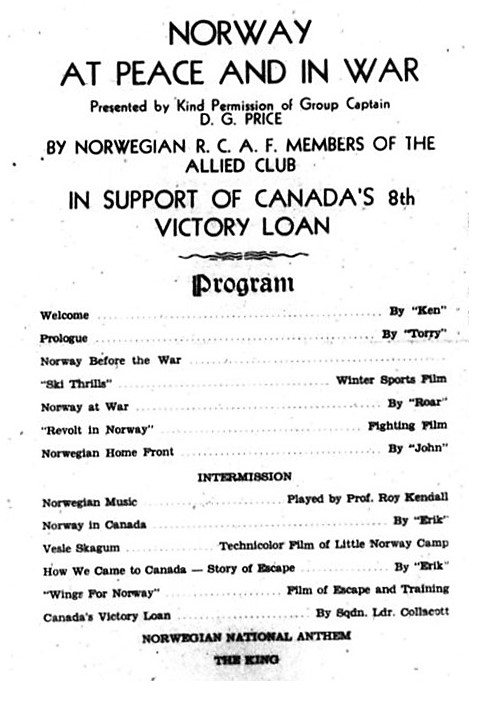
A special Norway 8th Victory loan program was held at the school on 2 May 1945, and the war was over in Europe five days later. The 20 minute “March of Time” July 1941 film “Norway in Revolt” was shown.

The very last class of ten Norwegians graduated from RCAF No. 2 Air Navigation School on 22 June 1945, Course #121. In total 22 Norwegian students graduated from No. 2 A.N.S. Summerside, P.E.I. The school was disbanded 7 July 1945.
No. 4 Bombing and Gunnery School at Fingal, Ontario, opened on 25 November 1940. The first three Norwegian students arrived for Course #17, 14 April 1941. They graduated on 7 June 1941, and appeared in the July “Observer” school newsmagazine. The three RNAF students were A. Fjallstad, Alf Steffen-Olsen, and Chris Krogh.


Course #22, 16 August 1941, graduated four RNAF Air Observer students.
Course #24, 1 January 1942, Wireless Air Gunners, graduated 2nd Lt. P. Jespersen and one RNAF airmen student.
Course #38, 3 March 1942, graduated one RNAF student.
Only ten Norwegian students trained and graduated from No. 4 B & G School at Fingal, Ontario.

Norwegians were also posted to special RCAF training schools across Canada. No. 8 Bombing and Gunnery School at Lethbridge, Alberta, conducted the first course on Aircraft Recognition, and Lt. F. Loberg RNAF was on this course beginning 20 June 1942.
Records in Ottawa, Canada, state 677 Norwegian aircrew graduated and received flying badges. Four hundred and twenty-six pilots were trained to the elementary level at Little Norway, [Toronto and Muskoka] and they were posted to RAF and RCAF schools where they received their wings. The Daily Diary of each school records the following totals:
No. 32 SFTS, Moose Jaw, Sask., [RAF] graduated 104 RNAF pilots, No. 34 SFTS, Medicine Hat, Alberta, [RAF] graduated 99 RNAF pilots, No. 16 SFTS, Hagersville, Ontario, [RCAF] graduated 49 pilots and No. 1 SFTS, Camp Borden, [RCAF] graduated 87 pilots. That’s a total of 330 pilots out of 426 trained in Canada.
Ottawa records show 251 Norwegian aircrew were trained in BCATP schools, and graduated with a badge. My Daily Diary records show 87 were trained at No. 1 B & G School Jarvis, Ontario, and No. 1 A.O.S. Malton, Ontario. No. 4 B & G School Fingal, trained ten RNAF students, and 100 graduated from No. 1 General Reconnaissance School, Summerside, P.E.I., plus 43 at No. 31 G.R.S. Charlottetown, P.E.I. RCAF No. 1 Navigation and Reconnaissance, Summerside, P.E.I graduated six RNAF, and RCAF No. 2 Air Navigation graduated 26 RNAF students.
Give or take one or two, that adds up to 272 aircrew members [some being pilots] and 330 pilots, total 602 out of 677. Twenty-three pilots were killed flying, seven died in accidents, and ten aircrew members were killed in training, total forty killed in Canada. It appears 35 RNAF [Army and Navy] pilots were possibly fully trained at Little Norway, Toronto Island Airport, from 21 September 1940 to March 1941, where they received their wings.
Muskoka’s “Little Norway” officially closed on 16 April 1945, and the flying school was shipped to Great Britain, along with 75 Fairchild aircraft and the two Cadet aircraft. Thirty of these aircraft arrived in Norway between June and July 1945. Some are in museums today.





